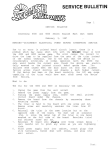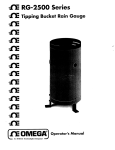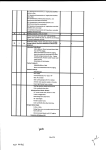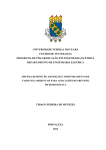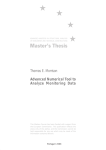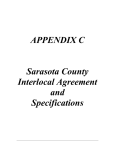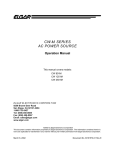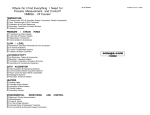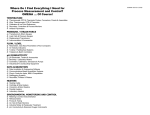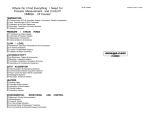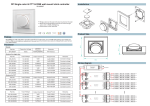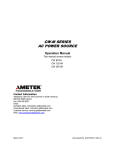Download Omega RG-2501 Weather Radio User Manual
Transcript
BL RG-2501 Series @m Tipping Bucket Rain Gauge .a OMEGx] Operator’s Manual b An OMEGA Technologies Company I Servicing USA and Canada: Call OMEGA Toll Free USA One Omega Drive, Box 4047 Stamford, CT 06907-0047 Telephone: (203) 359-1660 FAX: (203) 359-7700 Canada 976 Bergar Lava1 (Quebec) H7L 5Al Telephone: (514) 856-6928 FAX: (514) 856-6886 Sales Service: l-800-826-6342 / l-800-TC-OMEGASM Customer Service: l-800-622-2378 / l-800-622-BESTSM Engineering Service: l-800-872-9436 / l-800-USA-WHENSM TELEX: 996404 EASYLINK: 62968934 CABLE: OMEGA Servicing Europe: United Kingdom Sales and Distribution Center 25 Swannington Road, Broughton Astley, Leicestershire LE9 6TU, England Telephone: 44 (1455) 285520 FAX: 44 (1455) 283912 The OMEGA Complete Measurement and Control Handbooks & Encyclopedias Y* Temperature t, Pressure, Strain & Force u* Flow and Level Yr pH and Conductivity V Data Acquisition Systems I/ Electric Heaters V Environmental Monitoring and Control Call for Your FREE Handbook Request Form Today: (203) 3591RUSH MSS0395FvR18 Unpacking Instructions w Remove the Packing List and verify that you have received all equipment, including the following (quantities in parentheses): RG-2501 Tipping Bucket Rain Gauge (1) Operator’s Manual (1) If you have any questions about the shipment, please call the OMEGA Customer Service Department. When you receive the shipment, inspect the container and equipment for signs of damage. Note any evidence of rough handling in transit. Immediately report any damage to the shipping agent. The carrier will not honor damage claims unless all shipping material is saved for inspection. After examining and removing contents, save packing material and carton in the event reshipment is necessary. TABLE OF CONTENTS Chapter 1 Introduction ......................................... 1.1 General Description .................................... 1.2 Specifications ........................................ 1 1 2 Chapter 2 Installation .......................................... 2.1 Site Requirements ..................................... 2.2 Installation .......................................... 2 2 3 Chapter 3 Operation . . . . . . . . . . . . . . . . . . . . . . . . . . . . . . . . . . . . . . . . . . .3 Chapter 4 Calibration .......................................... Table of Standard Calibration Quantities .......................... Chapter 5 Maintenance Chapter 6 Troubleshooting . . . . . . . . . . . . . . . . . . . . . . . . . . . . . . . . . . . . . , , . . 5 . . . . . . . . . . . . . . . . . . . . . , . . . . . . . . . . . . . . . . .6 4 5 Chapter 1: Introduction 1.1 General Description The OMEGA@ Model RG-2501 Tipping Bucket Rain Gauge provides an inexpensive yet accurate method for measuring and recording rainfall. The tipping bucket design provides a means for operating an magnet-sensitive switch. The switch contact closure may be used with electro-mechanical counters, event recorders or electronic recording equipment to automatically obtain a record of the rainfall. The standard model of the rain gauge, Model RG-2501, produces a switch closure for each 0.01 inch of rainfall. The Model RG-2501M switch closure represents 1 millimeter of rainfall. Other calibrations of the rain gauge are available upon request. The tipping bucket design allows unlimited measurements since the tipping action dumps the water out of the bucket on alternating tips. Drain holes in the base plate allow the water to drain out of the gauge. All OMEGA@ rain gauges are made of the highest quality materials to provide long term, trouble free operation with a minimum of maintenance as long as each gauge has been properly installed and maintained. Parts of the rain gauge are made of aluminum with anodized or painted finishes. Fasteners are all stainless steel except for the aluminum pop rivets used to hold the bug screens in place. Some components are made of plastic, including the terminal block, the signal cable strain relief, the calibration screw acorn nuts, the bearing spacers, and the bearing inserts. The basic rain gauge assembly includes a removable outer funnel, the tipping bucket assembly, the magnet and switch assemblies, and the outer housing assembly. The main sensor assembly with the tipping buckets, switch, magnet and signal terminal block is mounted onto a bracket that is fastened to the base plate. Two adjustable screws provide the calibration of the buckets by changing the position of the bucket stop point. Three adjustable legs allow the gauge to be fastened permanently onto a platform or deck using standard fasteners. Slots in the legs provide some adjustment for leveling the gauge. A two-conductor, shielded cable with a wire size between 18 and 24 AWG should be used to connect the rain gauge output into the monitoring or recording equipment. A two position terminal block is provided for attaching the cable into the switch. Power for operating the switch originates within the monitoring/recording equipment and is typically a pulse ranging from 5 to 12 VDC. The Model RG-2501 and RG-2501M rain gauges are not available in heated versions for use in cold climates. These two gauges are designed and sold as low cost general purpose rain NovaLynx gauges and are best suited for standard rainfall measurements only. Refer to the catalog or contact the company to obtain information regarding other types of rain gauges that are available for more specialized uses. 1 1.2 Specifications Capacity: unlimited Orifice: 8” (20 cm) diameter Calibration: O.Ol”, 1 mm, 0.5 mm, 0.25 mm Accuracy: + 4% for rainfall rates of 1” to 6 ” per hour Switch: magnetic sensitive, 3 W, 28 Vat Construction: Fabricated parts: anodized aluminum Fasteners: stainless steel (except for aluminum rivets) Mounting: 3 legs, l/4” diameter bolt holes on a 9-l/2” diameter bolt circle Dimensions: 8.4” D x 15 ” H Shipping weight: 8 lbs Optional Accessories: Wind Screen, Alter Type Event Recorder, Drum Chart Calibrator Bottle Digital Event Counter Model RG-952 Model RG-952 Model RG-2596 Model RG-2596 Chapter 2: Installation 2.1 Site Requirements Finding the best possible site for the gauge is important and careful consideration should be given to the quality of precipitation catch prior to the final installation. The most accurate rainfall measurements are made in sheltered areas that block wind and eddy currents in the vicinity of the gauge. The best exposures are often found in orchards or openings within a grove of trees, bushes, or shrubbery. Fences or other objects can act together to serve as an effective windbreak. As a general rule in such areas, the heights of the objects and the distance from the gauge should be uniform. The height of nearby objects above the gauge should not exceed about twice their distance from the gauge. Individual or small groups of isolated objects near a gauge may set up serious eddy currents. Since it is not always possible to select sites that provide adequate protection from adverse wind effects, an open site away from isolated objects may be the only location available. Wind Shields help minimize loss of precipitation catch by breaking up the air flow immediately over the gauge funnel. Wind effects on catch losses are much greater during snowfall than rainfall. Windshields are not generally installed at gauge site locations where snowfall constitutes less than 20% of the mean annual precipitation. Good exposures are not always permanent. The growth of vegetation, trees, and shrubs can change an excellent exposure into an unsatisfactory one within a relatively short time. Sites should be inspected and groomed regularly. 2 In areas where heavy snowfall occurs, rain and snow gauges are mounted onto supports (tower) at a height well above the average snow level. A location with this type of exposure would be improved if the tower can be located within an area of trees of comparable height. 2.2 Installation The RG-2501 rain gauge may be shipped from the factory with the three mounting legs attached upside down on the l/4-20 bolts. If this is the case, detach and replace the legs into the correct position with the legs pointing downward and the leg end facing outward, away from the gauge. (Refer to the assembly drawing.) Be sure the leg mounting bolts are tightly fastened. Carefully remove all packing material and any tape, foam pieces, or rubber bands used to keep the tipping bucket from moving during shipment. Operate the tipping bucket to verify that the bucket can now move freely. Place the funnel into the top of the gauge. The gauge housing must be mounted as level as l/4” diameter mounting possible on its platform. The holes in the mounting legs are sized for bolts. For correct measurement of precipitation, the open end edge of the rain gauge funnel must lie in a horizontal plane. This can be tested by laying a carpenter ’s level across the top edge of the gauge funnel using two 90 ” directions: one direction crossing the other at right angles. If the top is not level in both directions, the condition should be corrected. Washers can be used as leveling shims between the mounting legs on the gauge and the platform or tower mounting plate. Place the bug and debris screens into place inside the funnel. Upon completion of the rain gauge mounting, route the signal cable to the monitoring/recording equipment. Use the most direct route possible, avoiding sharp or jagged objects that may rub against the cable jacket during high winds causing exposure of the wires. Attach the cable to the structure or support using plastic wire ties or other appropriate devices. When using plastic wire ties, use only black, ultraviolet resistant, wire ties, placing them at a spacing of two to three feet along the cable length. for best results, whenever possible, the signal cable should be routed through conduit. Chapter 3: Operation Precipitation entering the collection orifice fills the calibrated tipping bucket assembly. When the calibrated amount has been collected, the bucket tips, causing a momentary closure of the reed switch, and sending an electrical signal to the event recorder or other data collection device. The precipitation sample is discharged out of the gauge at the same time. 3 Chapter 4: Calibration The rain gauge is calibrated at the factory. Recalibration should not be necessary unless damage during shipment or mishandling during installation has occurred. If the damage is extensive, the gauge may need to be repaired or replaced before it can be used properly. Verify the calibration by using a calibration bottle, a graduated cylinder, or a calibrated burette. The calibration is verified by allowing a known volume of water to flow into the funnel at a rate of 1 to 2 inches per hour producing a specific number of bucket tips. Before putting the volume of water into the funnel run some water into the gauge to wet the funnel and the buckets. The gauge calibration test must be made while the gauge is wet. Do not ’ wipe off any water especially from the buckets between tests and calibration screw adjustments. Add the measured amount of water at the specified flow rate (refer to Table 1 The bucket should tip within the published gauge tolerances and should give the calculated number of tips within the gauge accuracy. If the number of counts is not within the gauge accuracy, then the bucket stops must be adjusted to increase or to decrease the amount of water needed to tip the buckets. The individual buckets can be calibrated by placing an amount of water equal to one tip into the bucket and adjusting the bucket stop on the opposite side of the gauge until the bucket tips and empties its water. To move the bucket stop screw first loosen the hex nut on the outside of the rain gauge. The nut keeps the screw locked into place. With the nut loosened, the screw can be rotated by hand or by using a screw driver set into the head of the screw. The screw should only be rotated by a small amount between each test. Use a large rotation of the screw only if the bucket is out of calibration by a large number of counts. Note that moving the bucket stop screw upward means that less water is needed to tip the bucket and moving the screw downward increases the amount of water needed to tip the bucket. For inches of rain, the amount of water needed for a single tip equal to 0.01 inches is 8.24 milliliters. For a 1 millimeter tip the amount of water is 32.43 milliliters. Add the amount of water needed to each of the buckets separately and adjust the corresponding stop screws as needed to obtain a single tip form each bucket. Several adjustments of each calibration screw may be necessary as there will be some influence from each of the buckets upon the other as the adjustments are changed. If there is repeatability in the tip with the calibrated amount of water, then the adjustment screw has been correctly set and can be locked into place. Use the hex nut located on the adjustment screw at the outside the rain gauge base to lock the screw into position. Take care and do not allow the screw to rotate as the nut is being tightened. In case the screw has turned slightly, retest the tip of the bucket after the nut has been tightened. 4 ). Table 1 - Standard Calibration Quantities 260-2501M @ 1 mm (std) Cal: 32.43 260-2501M @ .5 mm Cal: 16.215 milliliters 260-2501 @ .Ol” (std) Cal: 260-2501 @ .05” Cal: 8.24 41.2 s milliliters milliliters milliliters Flow rate for calibration: l/2 ml per second. Accuracy desired is & 4% of volume at 1-6 inches precipitation per hour. After making changes to the bucket stop screws, retest the rain gauge operation using the calibration bottle and a large volume of water to produce 50 to 100 tips at a rate of 1 to 2 inches per hour. Remember to thoroughly wet the funnel and buckets first! The total number of tips generated should correspond to the volume of water run through the gauge (expressed in milliliters; 1 quart = 946.3 milliliters) divided by the calibration quantity indicated in milliliters in Table 1. A tolerance of + 6% or better should be obtained through testing using this method. A more accurate test can be made in the lab using controlled conditions and more accurate test equipment. Chapter 5: Maintenance Rain gauges require regular maintenance. Gauges located in heavily forested areas or where airborne debris is a consideration should be serviced more often. The bucket assembly and drain screens should be inspected to ensure they are clean and free from debris such as leaves and insects. The tipping buckets should be carefully wiped clean to remove mud and dirt. Inspect the small tube of the main funnel and remove any obstructions inside it. Test the gauge for correct operation and accuracy of the tipping buckets. Refer to Section 4. Annually or after 6 months of heavy operation, put a drop of light machine oil onto each rotating part, specifically, the bucket assembly shaft at the bearings. Should the tipping bucket fail to rotate freely about its axis, check the two small right angled brackets that hold the shaft and the bearings onto the main mounting bracket. These two brackets can become loosened or misaligned causing the shaft to bind. The brackets ’ edges should be at the same level. Severe friction will create excessive wear in the plastic bushings resulting in the magnet making contact with the switch and stopping the bucket assembly from tipping. Replace worn 5 or damaged bushings. Too many bushings may cause the bucket shaft to bind as well. If a bushing needs to be removed, remove it from the side away from the magnet and switch allowing more room between the magnet and switch. The number of bushings will vary from gauge to gauge depending upon variations in the materials used. Typically there are four bushings on each side of the shaft. Check the magnetic switch for proper operation. The standard switch closure is a momentary single pole, normally open (SPNO) contact. Connect an ohmmeter to the gauge at the signal cable terminal strip. With the bucket assembly at rest upon one of the calibration screws, the ohmmeter should read infinite resistance. Slowly move the bucket assembly to simulate a rain event until the bucket assembly has fully rotated. As the magnet passes over the end of the barrel switch, the resistance of the switch should change to a short (zero or less than one ohm). As the tipping bucket comes to a complete tip and rests upon the other calibration screw the ohmmeter will again read an infinite resistance. Upon completion of all testing and maintenance, replace the funnel into the gauge housing. Confirm that the gauge is still level by checking as described in Section 2.3. In order to maintain the accuracy of the rainfall catch, the rim of the funnel should be protected from dents or other damage that might alter its shape. Chapter 6: Troubleshooting If it becomes necessary to correct an operation problem always perform the following step first: Check the cable connections to ensure a solid connection. A loose or faulty cable is often the problem to missing data. Next, check to see that the bucket assembly moves freely upon its pivoting shaft. Make sure that the magnet has not become loose and is securely in place on the bucket. Check to ensure proper contact closure. Refer to Section 5.4. If the gauge registers low or not at all during a precipitation event, check for debris in the inlet funnel and drains that might be blocking bucket movement. If the gauge registers high during precipitation, check the level bubble indicator to ensure the sensor is properly installed and leveled. Recheck calibration. Whenever the gauge is to be used with an electro-mechanical counter or event recorder, surge protection diodes must be installed between the gauge and the equipment. Failure to install these diodes will result in a stuck magnetic switch due to electrical interference from the counter or recorder solenoids. Some gauges have been shipped with these diodes installed across the signal terminal block inside the gauge. If it appears that the diodes have not been included on your gauge and that they will be needed for your application, please contact OMEGA@ and arrange to have a set of diodes sent, one set per gauge. 6 d i \ c I 4 a I ’ r -----_ I I I I I I 1 I I I I I I I I I I I I I - - WIR TO EVEN OR PROTECTION DIODE OR 1 SKE27A 1.5KE27C (Xl ) ow RAIN GAUG E BARREL SWlTCt -I 1’1 TLE ATTACH SURGE SUPPRESSION DIODE(S TO RAIN GAUGE SWITCH OR TO INPU OF RECORDER OR COUNTER . T ) SCHEMATIC, R SWITCH SURGE MODEL USAGE DATE 260 , SCALE D l 3Y I - 260 2501 - 8 &FULL d _ ------- .G? i A ) __ z GE AU ZCTION A- A NI G RA, LY 2501 - MB L 260 D PARTS LIST FOR TIPPING BUCKET RAIN GAGE MODEL 260-2501 8 INCH ORIFICE, 0.01”PER TIP EC0 980102 NL P/ N DESCRIPTION 10000049 10000069 10000070 10000072 10000076 10000077 10000078 10000079 10000116 10000224 10000225 21051401 41500302 41900600 46311501 51001802 SCREEN, DRAIN BRACKET, BUCKET SHAFT SUPPORT BRACKET, BUCKET SUPPORT MOUNTING LEG, RAIN GAGE SUPPORT BODY ASSEMBLY, OUTER CASE BRACKET, BARREL SWITCH BUCKET WITH SHAFT ASSEMBLY MAGNET WITH BRACKET ASSEMBLY FUNNEL ASSEMBLY, 8 INCH SCREEN, LOWER FUNNEL, 2 ” DIA SCREEN, UPPER FUNNEL, 7 5/8” DIA TERMINAL BLOCK, 2 PIN STRAIN RELIEF, SIGNAL CABLE SPADE LUG, #6 NYLON INSULATED SURGE PROTECTION DIODE 1.5KE27C BARREL SWITCH BEARING, NYLON INSERT, PRESS FIT SPACER/WASHER, NYLON 0.44 OD X 0.2 ID X 0.033 THK SCREW 4-40 X l/4 FLAT HEAD SS SCREW 4-40 X 3/8 PAN HEAD SS WASHER, #4 LOCK SS SCREW, 6-32 X 3/8 PAN HEAD SS WASHER, #6 FLAT SS WASHER, #6 LOCK SS SCREW, lo-32 X l/2 PAN HEAD SS SCREW, lo-32 X 3 PAN HEAD SS NUT, #lO HEX SS NUT, #lO ACORN, NYLON WASHER, #lO FLAT SS WASHER, #lO LOCK SS RIVET, l/8 X l/4 ALUM 71010100 72310503 7206040 1 72083301 72341001 72082002 72302101 72341101 72188003 72083003 72211410 72246310 7230030 1 72340210 72380000 QTY 2 2 1 3 1 1 1 1 1 1 1 1 1 4 1 1 2 8 2 3 3 5 5 5 6 2 2 2 6 6 4 WARRANTY OMEGA warrants this unit to be free of defects in materials and workmanship and to give satisfactory service for a period of 13 months from date of purchase. OMEGA Warranty adds an additional one (1) month grace period to the normal one (1) year product warranty to cover handling OMEGA ’s customers receive maximum coverage on each and shipping time. This ensures that product. If the unit should malfunction, it must be returned to the factory for evaluation. OMEGA ’s (AR) number immediately upon Customer Service Department will issue an Authorized Return phone or written request. Upon examination by OMEGA, if the unit is found to be defective it will be repaired or replaced at no charge. However, this WARRANTY is VOID if the unit shows evidence of having been tampered with or shows evidence of being damaged as a result of excessive corrosion; or current, heat, moisture or vibration; improper specification; misapplication; misuse or other operating conditions outside of OMEGA ’s control. Components which wear or which are damaged by misuse are not warranted. These include contact points, fuses, and triacs. OMEGA is glad to offer suggestions on the use of its various products. Nevertheless, OMEGA only warrants that the pa defects. OMEGA MAKES NO OTHER WARRANTIES OR REPRESENTATIONS OF ANY KIND WHATSOEVER, EXPRESSED OR IMPLIED, EXCEPT THAT OF TITLE AND ALL IMPLIED WARRANTIES INCLUDING ANY WARRANTY OF MERCHANTABILITY AND FITNESS FOR A PARTICULAR PURPOSE ARE HEREBY DISCLAIMED. LIMITATION OF LIABILITY: The remedies of purchaser set forth herein are exclusive and the total liability of OMEGA with respect to this order, whether based on contract, warranty, negligence, indemnification, strict liability or otherwise, shall not exceed the purchase price of the component upon which liability is based. In no event shall OMEGA be liable for consequential, incidental or special damages. Every precaution for accuracy has been taken in the preparation of this manual; however, OMEGA ENGINEERING, INC. neither assumes responsibility for any omissions or errors that may appear nor assumes liability for any damages that result from the use of the products in accordance with the information contained in the manual. SPECIAL CONMTION: Should this equipment be used in or with any nuclear installation or activity, purchaser will indemnify OMEGA and hold OMEGA harmless from any liability or damage whatsoever arising out of the use of the equipment in such a manner. RETURN REQUESTS / INQUIRIES Direct all warranty and repair requests/inquiries to the OMEGA ENGINEERING Customer Service Department. BEFORE RETURNING ANY PRODUCT(S) TO OMEGA, PURCHASER MUST OBTAIN AN AUTHORIZED RETURN (AR) NUMBER FROM OMEGA ’S CUSTOMER SERVICE DEPARTMENT (IN ORDER TO AVOID PROCESSING DELAYS). The assigned AR number should then be marked on the outside of the return package and on any correspondence. FOR WARRANTY RETURNS, please have the following information available BEFORE contacting OMEGA: 1. P.O. number under which the product was PURCHASED, 2. Model and serial number of the product under warranty, and 3. Repair instructions and/or specific problems relative to the product. FOR NON-WARRANTY REPAIRS OR CALIBRATION, consult OMEGA for current repair/ calibration charges. Have the following information available BEFORE contacting OMEGA: 1. P.O. number to cover the COST of the repair/calibration, 2. Model and serial number of product, and 3. Repair instructions and/or specific problems relative to the product. OMEGA’s policy is to make running changes, not model changes, whenever an improvement is possible. This affords our customers the latest in technology and engineering. OMEGA is a registered trademark of OMEGA ENGINEERING, INC. (0 Copyright 1995 OMEGA ENGINEERING, INC. All rights reserved. This documentation may not be copied, photocopied, reproduced, translated, or reduced to any electronic medium or machine-readable form, in whole or in part, without prior written consent of OMEGA ENGINEERING, INC. Where Do I Find Everything I Need for Process Measurement and Control? OMEGA...Of Course! TEMPERATURE m Thermocouple, RTD & Thermistor Probes, Connectors, Panels & Assemblies m Wire: Thermocouple, RTD & Thermistor @ Calibrators & Ice Point References @ Recorders, Controllers & Process Monitors @ Infrared Pyrometers PRESSURE/STRAIN FORCE w Transducers & Strain Gages & Load Cells & Pressure Gauges & Displacement Transducers m Instrumentation & Accessories FLOW/ LEVEL @ Rotameters, Gas Mass Flowmeters & Flow Computers @ Air Velocity Indicators @’Turbine/Paddlewheel Systems @’Totalizers & Batch Controllers H/CONDUCTIVITY & pH Electrodes, Testers & Accessories @ Benchtop/Laboratory Meters @’Controllers, Calibrators, Simulators & Pumps m Industrial pH & Conductivity Equipment DATA ACQUlSlTlON @’ Data Acquisition and Engineering Software m Communications-Based Acquisition Systems m Plug-in Cards for Apple, IBM & Compatibles & Datalogging Systems @’Recorders, Printers & Plotters HEATERS @’Heating Cable @’Cartridge & Strip Heaters @’Immersion & Band Heaters D Flexible Heaters & Laboratory Heaters ENVIRONMENTAL MONITORING AND CONTROL @’Metering & Control Instrumentation @’Refractometers m Pumps & Tubing m Air, Soil & Water Monitors @’ Industrial Water & Wastewater Treatment @’ gH, Conductivity & Dissolved Oxygen Instruments M2235/0395
















